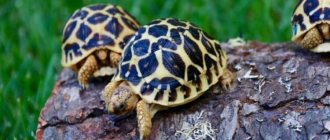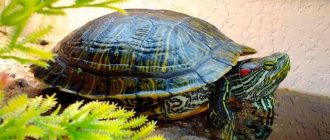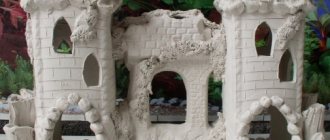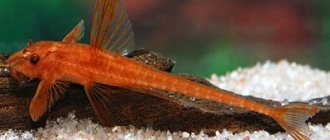Review author: “ZooVita”
Turtles are interesting animals. They have been very popular in Europe for many years, and for good reason. They do not create problems when it comes to care, but breeding these reptiles requires the owner not only to acquire knowledge, but also to be willing to deepen it.
Content
“I want to have a turtle at home,” parents often hear from their children. This reptile is an ideal pet for a child, recommended by doctors, because, theoretically, it does not cause allergies.
On the other hand, they are demanding and rather fragile animals. A common mistake in keeping pet turtles is to simply keep them on the floor. They need to be provided with proper temperature, humidity, soil, and safety.
First you need to decide whether the turtle will be an aquatic pet or a typically land turtle. Each group requires different conditions. If it is water-land, a suitable aquaterrarium with the required amount of water is created.
Crumbs in the shell: the life period of little turtles
Not everyone is ready to have a large reptile at home. Much more often, babies up to 13 cm in size act as original pets. Despite their miniature size, such “cuties” live quite a long time.
Lifespan of a tiny turtle:
- three-keel - from 20 to 25 years;
- musky - 23;
- spotted - from 30 to 40;
- silt - from 50 to 60;
- Reeves (pond) - 58.
Requirements for aquatic reptiles
Often, pet stores sell coin-sized babies and convince the buyer that a 30-liter aquarium will be the ideal solution. This is mistake. Even for a small reptile, the aquarium must be spacious, but for an adult, it must be taken into account that a minimum of 200-300 liters of water will be required.
Effective filtration is required, preferably in the form of an external filter, appropriate lighting, including UV, and a proper diet. Aquaterrariums use soil and gravel.
Mr. Tail Explains: Common Mistakes
All problems with these unpretentious pets arise due to the owners’ ignorance of basic maintenance rules. Most often, turtle owners make the following mistakes:
- They do not provide any terrarium for their placement. The pet is forced to look for a secluded corner in the house on its own. He collects dust under cabinets and sofas, and can get hurt and catch a cold from drafts.
- They forget to install an ultraviolet lamp in the turtle's housing. The absence of this radiation spectrum can cause many diseases in your pet.
- Scales are forcibly removed from the skin and scutes from the shells during molting. This is absolutely forbidden to do so as not to injure your pet. When washing, use only a soft cloth.
- They keep several aggressive males together. This can lead to injury and even death to the turtles.
- Wash terrariums using homemade disinfectants. This can easily poison your pets. To clean their territory, you must have your own equipment and special means.
Keeping land turtles
For a land turtle, it is necessary to prepare a terrarium measuring at least 120 cm by 50 cm. The correct temperature must also be guaranteed.
In one part - 30-35 degrees Celsius with low humidity, and in the other - 25-28 degrees with humidity up to 70%. Then the reptile will be able to bask on the “island of heat” created using a heating lamp, or find a cooler place.
You need to choose the right substrate. For most terrestrial species, a homemade mixture of soil, sand and a small amount of clay works well. An alternative is turf, which is a dug-out piece of lawn containing soil.
Decorative elements and hiding places will decorate the terrarium and will be useful. Amphibians need several places to hide and feel safe. You can put pots, coconut shells, twigs with leaves. The presence of sufficient light is necessary for the normal development of the shell.
300 years - myth or truth? About the lifespan of turtles
For these reptiles the rule is: the more, the longer. How many years turtles live in the wild depends primarily on their size. Their lifespan can be 30 - 50 years (small), 80 years (medium) to 120 - 150 years (giant individuals).
How many years sea turtles live is determined by their size. They are usually large - from 70 to 140 cm. They live in warm seas and oceans. On average, they live up to 80 years in freedom. But most do not reach such a venerable age. Many die at the embryonic stage, while in the egg (due to unfavorable temperatures). Others are eaten by predators when the babies try to get to the water.
How many years do land turtles live? Depending on the size - from 50 to 100 years. Among them there are tiny ones - about 10 cm, but there are also large specimens. The latter, naturally, have a greater chance of surviving to “retirement” age.
Aquatic species are represented by medium-sized individuals. Their size does not exceed 30 cm. They take root well in captivity. They live for about 50 years, both in aquaterrariums and in the natural environment.
All of these reptiles have a slow metabolism, which explains their longevity. The most tenacious of them are large turtles. How many years do they live? From 100 to 120 years. Perhaps many of them could live to an older age, but in their natural habitat many dangers and diseases await them, so only a few of them die a natural death. There are record holders who lived 175 and even 188 years.
The maximum age of the largest reptiles is 200 years. There is evidence that some representatives of the giant tortoises living on the Galapagos Islands are over 300 years old.
Wood turtle
Scientific name: Glyptemys insculpta. Originally from North America. It is characterized by a dark gray shell. The legs, head and abdomen are orange with black spots, the limbs are short and strong.
Males are larger than females, the size of an adult is 23 centimeters, weight is about a kilogram. They are omnivores. In spring and summer it lives on the surface, in winter and autumn it chooses an aquatic environment.
Causes of premature death
The most common causes of death of pets are:
- Improper conditions of detention. Small aquarium, dirty unfiltered water, untimely cleaning, inappropriate temperature conditions.
- Infections. They can appear from aquarium plants, decorative elements, and live food.
- Poor nutrition and lack of vitamins. In nature, a turtle can compensate for the deficiency of any element on its own; when kept at home, monitoring the diet is the owner’s task.
- Lack of qualified veterinary specialists who can correctly and timely diagnose health problems and prescribe adequate treatment.
Reptile nutrition
What to feed pet turtles. Some aquatic species are typical predators, others have a certain percentage of plants in their diet, and others are vegetarians. You need to find out this before buying a pet. They eat live, dried, prepared and frozen food.
Before lunch, frozen food must be thawed and rinsed.
Live food:
- water larvae,
- mosquito larvae,
- tadpoles and frogs,
- daphnia,
- freshwater fish,
- aquarium fish (guppies, gladioli),
- water snails,
- bloodworm,
- water beetles.
However, you should not overdo it with the amount of animal food you eat. Although it should dominate the amphibian’s diet, we must not forget about plant foods:
- pansies,
- daisies,
- dandelion leaves,
- plantain leaves,
- aquarium plants,
- clover,
- water fern,
- raspberries,
- strawberry,
- watermelon,
- grape,
- apples,
- peaches
- apricots,
- tomatoes,
- Chinese cabbage.
Usually they give as much food as the animal can eat in 5 minutes. Adults should be fed 2-3 times a week, young (up to 6 months of age) - 1 time a day, newborns (up to 3-4 months of age) - 2 times a day.
How to determine age
Find out how many years a turtle lives by looking at its shell. The length increases by 2 cm with each passing year. A turtle is born with a 3-centimeter shell. Measure the length of the shell, subtract 3, divide the resulting number by 2. So, the age of a reptile with a shell 5 cm long is 1 year, 15 cm - 6 years.
Land
Each plate dividing the carapace contains annual rings. During the first 2 years of life, 6 annual rings are formed in land species. After this, 1-2 rings are added every year. Count the rings on one plate of the shell, subtract 6, divide by 1.5 and add 2. After counting 20 rings, you can find out that the animal is 11 years old.
One
In the inhabitants of the waters, 1 annual ring is added annually. Count the number of rings on the plate and subtract the first 2 years of life. In older individuals, the pattern is unclear and blurry.
Hibernation and reproduction
The statement that turtles must hibernate every year is not always true. At home, this is not even advisable. Only a specialist can prepare an animal for hibernation and ensure the correctness of such rest, otherwise it will sleep forever.
If your pet stays in a corner of the terrarium for a long time and tries to burrow into the ground, it is probably getting ready for sleep. To prevent this from happening, it is necessary to fatten it and carefully read specialized literature on ensuring turtle hibernation so that the animal remains alive and healthy. With good care and proper nutrition, pets can live 15-30 years.
If you are serious about running a “turtle” business, it is better to start with 3 individuals of the same age and size - 2 females and 1 male. More than two men compete for territory and ladies. It is better to keep aquatic reptiles separately, allowing them to be together only for mating.
When buying a pet, you need to pay attention to the behavior - this will tell you whether the individual is healthy. The shell should be without cracks, there should be no spots on the skin, the mucous membrane of the mouth should be pale pink in color, saliva should not be sticky, breathing should be calm, no discharge from the mouth or nose.
Most turtles carry salmonella, as well as other bacteria and viruses that can be dangerous (especially to children). Therefore, you need to ensure that your child washes their hands thoroughly when coming into contact with a turtle.
Aquatic turtle: lifespan in artificial conditions
Let's start with the most popular type of such reptiles: how many years do red-eared turtles live? If you provide them with proper care, they will delight you with their presence for 25 to 30 years (the same applies to yellow-eared ones). Depending on the size of the aquarium, they can grow to the size of a large saucer (maximum - up to 30 cm). They look peculiar and can make sounds resembling a squeal or hiss.
The average lifespan of aquatic turtles living in a human home is:
- silt loggerhead - 23 years;
- Trionix Chinese Far Eastern - from 25 to 30;
- Caspian - 25;
- European marsh - 25.
On a note! Aquatic turtles require an aquarium with a pond and an island where they can rest! They definitely need access to air. And change the water promptly!
Photos of pet turtles
Animal Species
Based on the way reptiles climb into their shells when in danger, two suborders are distinguished:
- Side-necked. The head is hidden in the direction of one of the paws.
- Hiddencervical. The neck is folded in an S-shape.
Experts identify several varieties of turtles living on land:
- Elephant (Galapagos). The weight of the animal sometimes reaches 390 kg, length 1.8 meters. The size of reptiles depends on the climatic conditions of their habitat. In arid areas, the shell is saddle-shaped and the limbs are long. In areas with high humidity, the carapace is dome-shaped.
- Egyptian. The smallest turtle. The size of males is no more than 12 cm. Females are larger. The shell has a brownish tint. Habitat: Middle East.
- Land Central Asian tortoise. Body about 19 cm. Carapace yellow with spots, round. The forelimbs have four toes. This is the most popular type for home maintenance. The land turtle lives up to 49 years. Habitat: India, Syria, Tajikistan, Uzbekistan, Kyrgyzstan. Due to capture for sale, the population has practically disappeared.
- Panther. The length of the animal's shell is more than 0.8 m, weight is about 49 kg. The carapace is dome-shaped and tall. Its color is yellow-sandy. Young turtles have a clearly visible dark brown spotted pattern. As the animal grows, it disappears. Habitat: Africa.
- Speckled Cape. The smallest turtle on Earth. The size of the shell is no more than 9 cm, weight from 96 to 164 grams. Lives in Namibia and South Africa.
Turtles live everywhere. The exceptions are: Greenland, Antarctica, Arctic, New Zealand.
RESULTS
LOSS, FUCK!:
RUR 50 RUB одов
REPORT:
ROOM умирают. RESULTS ²Ð¸Ð»ÑŒÐ½Ñ‹Ðµ уÑÐ»Ð¾Ð²Ð¸Ñ ÑодержаниÑ
Zim Invader:
30 rubles
REPORT***:
Черепаха редних размеров. 12—35 Ñм. Ratio 1.5 кг.
RESULTS ен в Ñ‚Ñ'мно-оли regurgitation ƒÑ€Ñ‹Ð¹, почти Ñ‡Ñ 'рный, цвет Ñ Ð¼ÐµÐ"кими жÑ'Ð"тыми пÑтнышРºÐ°Ð¼Ð¸, точками Ð ¸Ð»Ð¸ штрихами. ПлаÑтрон —тÑ'мно-бурый иÐ"и жеÐ"Ñ‚Ð¾Ð²Ð°Ñ‚Ñ ‹Ð¹ раР·Ð¼Ñ‹Ñ‚ыми Ñ‚Ñ'мными пÑтнами. RESULTS ые, Ñ Ð¼Ð½Ð¾Ð³Ð¾Ñ‡Ð¸Ñленными ж Ñ'лтыми пÑтнами. RESULTS, RESEARCH ой радуР¶ÐºÐ¾Ð¹. RESPONSIBILITY ƒÐµÑ‚.
RESULTS RESULTS s... ¾Ð¼. ‚‚‚‚‚ RESULTS LOSS.
RESULTS в возрате 5—9 Ð »ÐµÑ‚, при длине карапакÑа 9—12 Ñм.
RESULTS ‹Ðµ, Ñо Ñлабо Ð²Ñ ‹Ñ€Ð°Ð¶ÐµÐ½Ð½Ñ‹Ð¼ жÑ'лтым риÑунком и имеют бР¾Ð»ÑŒÑˆÐ¾Ð¹ желточный мешок нР° ROYALTY в течение зимы. 22—25 мм, маÑакÑаок оло 5 г.
registry ½Ð¾Ð¹ черепахи ÑÑƒÑ „ registry: registry +30°С Ð ¸Ð· них поÑвлÑÑŽÑ ‚ÑÑ Ñ‚Ð¾Ð”ÑŒÐºÐ¾ Ñамки, а при температуре ниР¶Ðµ +27°С — тол Sorry. ‚При › RESULTS ‚Ñ'ныши обоих поДов.
› ‹Ðµ черепахи могут price 25—30 rubles. RESULTS, RESPONSIBILITY, RESPONSIBILITY хи могут дожить 120 rubles.
la gente:
RESULTS
REPORT:
RESULTS µÑкольким признакам. RESULTS, RESPONSIBILITY, RESPONSIBILITY RESULTS ‚обы ему было удобнее удерживатьÑÑ Ð½Ð ° панцире Ñамки п This is the case. RESULTS RESULTS OPTION, OPTION µÐ¼ каймановых черепах, у крупнее. У некоторых видов Ñамцы имеют и друР³Ð¸Ðµ отличиÑ: на п sir, sir ½Ñ‹Ðµ когти registry RESULTS ‚а.
Taking care of your health
Compliance with all the rules for the care and maintenance of waterfowl turtles in a home apartment will protect the animal from possible infections and diseases. However, any pet can get sick. Common diseases and treatments are presented in the following table:
| Disease | Symptoms | Treatment |
| Abscess / Otitis | Tumor in the ears, on the limbs | Operation |
| Pneumonia | Does not drown, falls over, does not eat, wheezes, white mucus and bubbles appear from the nose | Deadly. Treated in a hospital or at home with injections |
| Conjunctivitis/swelling/redness of the eyes | Swollen eyes, redness, suppuration under the eyelids, lack of appetite | Local treatment |
| Soft/Twisted Shell (rickets / osteopenia / hypocalcification) | Softening of the shell, its curvature | The curvature process is irreversible; local treatment |
| Helminthiasis | Diarrhea/constipation, presence of helminths in tests | Treatment by a veterinarian |
| Dermatitis/skin fungus | Increased shedding, skin redness, white growths | Treatment by a veterinarian |
Main types
The species united by the common name “waterfowl turtle” are divided into:
- closing;
- flat;
- spotted;
- Chinese.
Closing
The species of secluded aquatic turtles is represented by the following subspecies:
- mud red-cheeked;
- mud walleye;
- musky keel;
- common musk.
The natural habitat of aquatic turtles of this species is the coasts of South and North America. All animals have a spherical carapace - a rib-shaped spine of the neck plate, which in case of danger the reptile tightly closes, thereby gaining complete protection.
Interestingly, the subspecies of mud turtles has developed dense membranes between the toes on the front and hind legs. Animals in nature rarely grow more than 15 centimeters in length, and the bulk of the diet consists of food of animal origin.
Flat
The species of flathead aquatic turtles has several subspecies of Homopus:
- boulengeri;
- areolatus;
- signatus;
- femoralis;
- solus.
Animals of this species are distinguished by a strongly elongated skull, and in adulthood they rarely exceed 10 centimeters in length. The head is proportional, there are special small protective shields on the neck, the carapace is convex, oval in shape, slightly extended forward. The shades of carapace range from dark brown to olive. Females are larger than males and lay up to 5 eggs in one clutch.
Spotted
A species of true amphibians, spotted water turtles are characterized by a unique ability to thrive only in tandem conditions of land and water in the conditions of their urban home. The aquarium of such an animal must be equipped with an island of land, on which the turtle will happily rest and also bask under the rays of a special heating lamp. The length of the reptile rarely exceeds 13 centimeters.
Chinese three-keel
Chinese turtles are most often found among new breeders. These wonderful animals are considered the easiest to keep and undemanding in terms of diet diversity. A water house with a volume of about 100 liters is suitable for this reptile, because the size of an adult individual of this species is only 12 centimeters.
Diseases
If conditions of detention are violated, marsh turtles are exposed to various diseases, the most common of which are:
- Dermatomycoses. With this disease, the shell or skin is affected, becoming covered with a dirty gray coating, under which the tissue subsequently begins to die. Individual plates of the shell may also begin to peel off, followed by its deformation. Treatment consists of using malachite green, which is added to water (0.15 mg per 1 liter of water). For 3 days, you should bathe your pet in the resulting solution for 15–20 minutes.
- Systemic mycoses. This disease most often affects the lungs. The clinical picture is practically absent, and the disease is diagnosed after autopsy. There is no cure for this disease.
- Viral infections. The first symptoms are inflammation of the eyes, pneumonia, refusal to eat. Necrotic changes occur in the upper respiratory tract and tongue. The mortality rate reaches 38%.
With proper care, all these ailments can be avoided.
Centenarians
The life expectancy of a land turtle is long. The following long-lived people are known:
- elephant named Harietta (175 years old);
- Galapagos giant male Jonathan (180 years old);
- Madagascar radiata Tui Malila, (192 years);
- Seychelles Advaita (150-250 years).
There is information from zoos that notes that some individuals of the box-shaped species have reached their centenary. Spurred ones can live up to 115 years, Balkan ones - up to 90-120 years, representatives of elephants celebrated their 150th anniversary in captivity.
Caymans in the wild also live on average to at least one and a half centuries, and Seychelles up to two and a half hundred years.
The registered maximum age of large land turtles is 250 years, and not 300, as Ranevskaya sings to us in the image of Tortilla in the film about Pinocchio. And the larger the reptile, the longer it can live, provided that nothing happens that disrupts its usual way of life.











